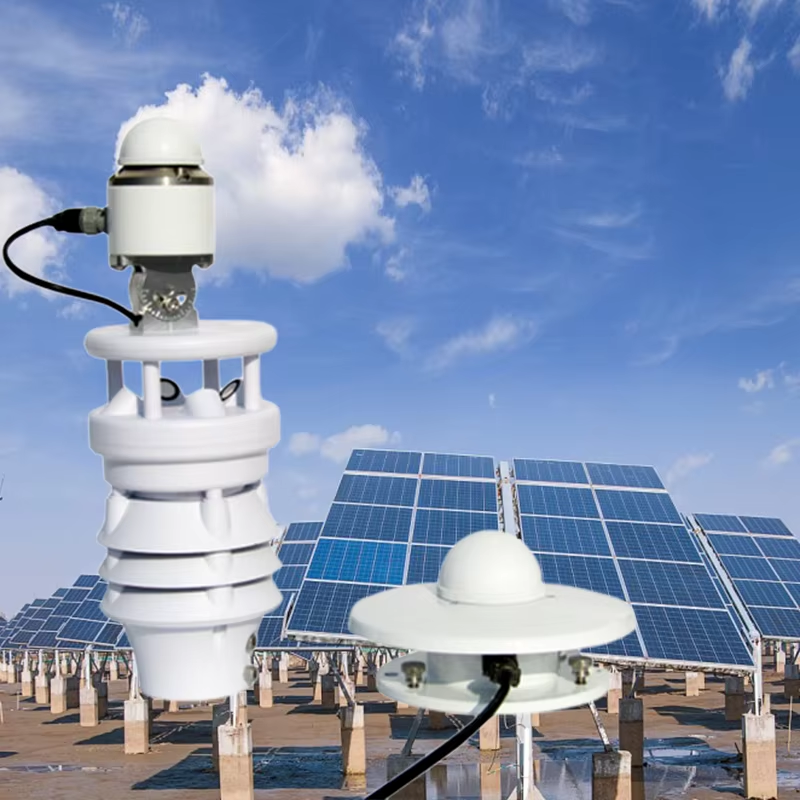1. Sääasemien määritelmä ja toiminnot
Sääasema on automaatioteknologiaan perustuva ympäristön seurantajärjestelmä, joka pystyy keräämään, käsittelemään ja lähettämään ilmakehän ympäristötietoja reaaliajassa. Nykyaikaisen meteorologisen havainnoinnin infrastruktuurina sen ydintoimintoihin kuuluvat:
Tiedonkeruu: Tallenna jatkuvasti lämpötila, kosteus, ilmanpaine, tuulen nopeus, tuulen suunta, sademäärä, valon voimakkuus ja muut keskeiset meteorologiset parametrit
Tiedonkäsittely: Tiedon kalibrointi ja laadunvalvonta sisäänrakennettujen algoritmien avulla
Tiedonsiirto: Tukee 4G/5G:tä, satelliittiviestintää ja muuta monitilaista tiedonsiirtoa
Katastrofivaroitus: Äärimmäiset sääolosuhteet laukaisevat välittömät hälytykset
Toiseksi, järjestelmän tekninen arkkitehtuuri
Tunnistava kerros
Lämpötila-anturi: Platinavastus PT100 (tarkkuus ±0,1 ℃)
Kosteusanturi: Kapasitiivinen anturi (alue 0–100 % suhteellinen kosteus)
Tuulimittari: Ultraääninen 3D-tuulimittausjärjestelmä (resoluutio 0,1 m/s)
Sademäärän seuranta: Kaatuvan kauhan sademittari (resoluutio 0,2 mm)
Säteilymittaus: Fotosynteettisesti aktiivisen säteilyn (PAR) anturi
Tietokerros
Edge Computing Gateway: ARM Cortex-A53 -prosessorilla varustettu
Tallennusjärjestelmä: Tukee SD-kortin paikallista tallennustilaa (enintään 512 Gt)
Aikakalibrointi: GPS/Beidou-kaksoistila-ajoitus (tarkkuus ±10 ms)
Energiajärjestelmä
Kaksoistehoratkaisu: 60 W:n aurinkopaneeli + litiumrautafosfaattiakku (-40 ℃ matala lämpötila)
Virranhallinta: Dynaaminen unitekniikka (valmiustilan virrankulutus <0,5 W)
Kolmanneksi, teollisuuden sovellusskenaariot
1. Älykkäät viljelykäytännöt (hollantilainen kasvihuoneklusteri)
Käyttöönottosuunnitelma: Asenna yksi mikrosääasema jokaista 500 m²:n kasvihuonetta kohden
Tietojen sovellus:
Kastevaroitus: kiertoilmapuhaltimen automaattinen käynnistys, kun kosteus on yli 85 %
Valon ja lämmön kertyminen: tehollisen kertyneen lämpötilan (GDD) laskeminen sadonkorjuun ohjaamiseksi
Tarkkuuskastelu: Vesi- ja lannoitejärjestelmän ohjaus haihtumisen (ET) perusteella
Hyötytiedot: Veden säästö 35 %, homesienen esiintyvyys väheni 62 %
2. Lentokentän matalan tuulenvaihtelun varoitus (Hongkongin kansainvälinen lentoasema)
Verkostojärjestelmä: 8 kaltevan tuulen havaintotornia kiitotien ympärillä
Varhaisvaroitusalgoritmi:
Vaakasuora tuulen muutos: tuulen nopeuden muutos ≥15 kt 5 sekunnin sisällä
Pystysuora tuulenleikkaus: tuulen nopeusero 30 metrin korkeudessa ≥10 m/s
Reagointimekanismi: Laukaisee automaattisesti tornin hälytyksen ja ohjaa ylösvetoa
3. Aurinkosähkövoimalaitoksen hyötysuhteen optimointi (Ningxian 200 MW:n voimalaitos)
Seurantaparametrit:
Komponentin lämpötila (takalevyn infrapunavalvonta)
Vaakasuora/kalteva tasosäteily
Pölylaskeuman indeksi
Älykäs sääntely:
Teho laskee 0,45 % jokaista 1 ℃:n lämpötilan nousua kohden.
Automaattinen puhdistus käynnistyy, kun pölyn kertyminen saavuttaa 5 %
4. Tutkimus kaupunkien lämpösaarekkeiden vaikutuksesta (Shenzhenin kaupunkiverkko)
Havaintoverkko: 500 mikroasemaa muodostaa 1 km × 1 km:n ruudukon
Data-analyysi:
Viheralueiden viilentävä vaikutus: keskimääräinen lasku 2,8 ℃
Rakennustiheys korreloi positiivisesti lämpötilan nousun kanssa (R² = 0,73)
Tiemateriaalien vaikutus: asfalttipäällysteen lämpötilaero päivän aikana on jopa 12 ℃
4. Teknologisen kehityksen suunta
Monilähteisen datan fuusio
Lasertutka tuulikentän skannaus
Mikroaaltoradiometrin lämpötila- ja kosteusprofiili
Satelliittipilvikuvan reaaliaikainen korjaus
Tekoälyllä parannettu sovellus
LSTM-hermoverkon sademääräennuste (parannettu tarkkuus 23 %)
Kolmiulotteinen ilmakehän diffuusiomalli (kemikaalipuiston vuotosimulointi)
Uuden tyyppinen anturi
Kvanttigravimetri (paineen mittaustarkkuus 0,01 hPa)
Terahertsiaaltojen saostumispartikkelispektrianalyysi
V. Tyypillinen tapaus: Vuoristotulvien varoitusjärjestelmä Jangtse-joen keskijuoksulla
Käyttöönottoarkkitehtuuri:
83 automaattista sääasemaa (vuoristorinteillä)
Vedenpinnan seuranta 12 hydrografisella asemalla
Tutkakaiun assimilaatiojärjestelmä
Varhaisvaroitusmalli:
Äkillisen tulvan indeksi = 0,3 × 1 tunnin sateen intensiteetti + 0,2 × maaperän kosteuspitoisuus + 0,5 × topografinen indeksi
Vastauksen tehokkuus:
Varoitusetua pidennettiin 45 minuutista 2,5 tuntiin
Vuonna 2022 varoitimme onnistuneesti seitsemästä vaarallisesta tilanteesta
Uhrien määrä laski 76 prosenttia edellisvuodesta
Johtopäätös
Nykyaikaiset sääasemat ovat kehittyneet yksittäisistä havaintolaitteista älykkäiksi esineiden internetin solmuiksi, ja niiden data-arvoa vapautetaan syvälle koneoppimisen, digitaalisen kaksosen ja muiden teknologioiden avulla. WMO:n maailmanlaajuisen havaintojärjestelmän (WIGOS) kehityksen myötä tiheästä ja tarkasta meteorologisesta seurantaverkosta tulee keskeinen infrastruktuuri ilmastonmuutoksen torjunnassa ja kestävän inhimillisen kehityksen päätöksenteon tukemisessa.
Julkaisuaika: 17. helmikuuta 2025


